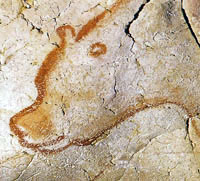Groningse koolstofdatering geeft debat over prehistorische grottekeningen nieuwe impuls

In 1994 ontdekte de Franse speleoloog Jean-Marie Chauvet in een grot bij Vallon-Pont d'Arc (Ardèche) een verborgen kamer waarvan de wanden bedekt waren met tekeningen van dieren. Prachtige prehistorische grotschilderingen, maar toen ze gedateerd werden, ontstond er een verhitte discussie tussen archeologen.
Koolstofdatering van de houtskooltekeningen door een Frans onderzoekslaboratorium wees namelijk uit dat de afbeeldingen ongeveer 30.000 tot 32.000 oud moesten zijn; daarmee zijn het de oudst bekende grotschilderingen, tweemaal zo oud als de tekeningen in de beroemde grot van Lascaux.
Verfijnde stijl
'Onmogelijk,' stelde Paul Pettitt, een befaamde Britse specialist op het gebied van grottekeningen, die verbonden is aan de University of Sheffield. De zeer verfijnde stijl van tekenen wijst er volgens hem onmiskenbaar op dat de tekeningen van veel recentere datum moeten zijn. Anders is het, aldus Pettitt, alsof je claimt dat je 'een Renaissance schilderij in een Romeinse villa' hebt aangetroffen.
Houtskool
Een uitgebreid onderzoek in 2001 (Nature, DOI: 10.1038/35097160) dat de eerdere Franse datering bevestigde, liet Pettitt niet van standpunt veranderen.
En ook een onderzoek naar houtskool, gevonden bij resten van vuurtjes in de grot, hoogst waarschijnlijk gebruikt om de tekeningen te maken, overtuigde hem niet. De datering, die werd uitgevoerd door prof.dr.ir. Hans van der Plicht in het 14C-laboratorium van de Rijksuniversiteit Groningen, kwam ook uit op een ouderdom van 30.000 jaar.
'Pettitt stelt echter dat de ouderdom van de houtskool niets zegt over de ouderdom van de tekeningen,' licht de Groningse dateringsexpert de mening van zijn Engelse collega toe. 'En daar zit wat in; je zou er natuurlijk op dit moment nog steeds een tekening mee kunnen maken.'
Holenbeer
In een nieuwe poging om het pleit te beslechten heeft de Franse paleogeneticus Jean-Marc Elalouf een onderzoek uitgevoerd naar de botten van holenberen die zijn gevonden in de Chauvet-Pont d'Arc grot en een grot bij het nabijgelegen Deux-Ouvertures. Ook aan dit onderzoek, dat binnenkort gepubliceerd wordt in de Journal of Archaelogical Science (nu al online, DOI: 10.1016/j.jas.2011.03.033), werkte de Groningse fysicus Van der Plicht mee.
Naast afbeeldingen van holenberen op de grotwanden zijn er tal van botten van deze reeds lang uitgestorven berensoort in de Chauvet-Pont d'Arc grot aangetroffen. Sterker nog, de bodem ligt er mee bezaaid. Elalouf liet de ouderdom van een aantal van die overblijfselen in Groningen met de 14C-methode onderzoeken. Daarnaast werd mitochondriaal DNA uit de botten geanalyseerd.
Het DNA-materiaal bleek weinig biologische variatie te vertonen - wat suggeert dat de populatie klein, en dus kwetsbaar, was - en de14C-datering laat zien dat overblijfselen van de holenberen 37.000 tot 29.000 jaar oud zijn.
Scepsis blijft
Ondanks deze nieuwe aanwijzingen blijft Pettitt sceptisch. Hij noemt het onderzoek volgens het populair wetenschappelijk tijdschrift New Scientist 'sloppy' en vraagt zich af of de getekende beren wel holenberen zijn, of misschien toch gewone bruine beren die nog heel lang in het gebied voorkwamen nadat de holenbeer daar was uitgestorven.
Elalouf stelt daar tegenover dat het laatste argument niet opgaat, omdat de twee soorten gemakkelijk kunnen worden onderscheiden aan de vorm van de kop. De grottekeningen beelden duidelijk holenberen af – een stelling die door op dit gebied deskundige biologen wordt bevestigd.
'En dan is er nog iets anders,' zegt Van der Plicht, die in het kader van het onderzoek de voor het publiek hermetisch afgesloten grot bezocht. 'Een van de tekeningen van een holenbeer is bekrast met een holenbeerklauw. Je zou zeggen, dat kan alleen maar door zo'n beer zelf zijn gedaan.'
Hoewel sluitend bewijs moeilijk is te geven, stapelen de aanwijzingen zich op, meent Van der Plicht. Volgens hem nadert het punt waarop 'de harde natuurwetenschapplijke methode voor datering van archeologische vonsten een omslag in het denken van de archeologen noodzakelijk maakt. En dat zou niet voor de eerste keer zijn.'
Meer nieuws
-
11 december 2025
Stormachtige planeten en een onverwachtse atmosfeer
-
09 december 2025
Faculty of Impact Grant voor nieuwe behandeling hersenkanker
